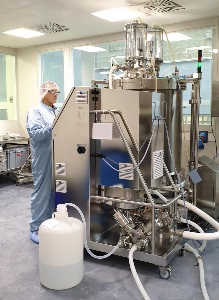Since being founded in 2003 by Marcel Raedts, Proxcys Downstream Biosystems B.V., Emmen, The Netherlands, has grown into one of the world’s leading producers of high-performance, low-pressure radial flow chromatography (HP-RFC) systems for use in the purification of biologicals from various sources, such as human blood plasma, cell cultures or bacterial fermentation.
“There is a bit of a difference between radial flow chromatography and traditional chromatography columns,” explained Thijs Groenewegen, Technical Sales Engineer for Proxcys. “Traditional columns flow from top to bottom, and while the RFC separation principle is the same, the column design is different. Instead of top to bottom, the RFC flow is from the outside to the inside of the column. We more or less turned the cylinder on its side, giving you a smaller footprint.”
What HP-RFC does have in common with traditional horizontal chromatography systems is the need for a reliable pumping technology that can be used in the critical stage involving the separation and purification of biopharmaceutical drug or target molecules from other molecules and impurities in the mixture. This purification is performed in a chromatography column, which is basically a cylindrical vessel fully packed with small 50-100µm chromatography beads, also called resin or sorbent, that is immobilized inside the column.
In this setup, the key to optimized performance is proper packing of the chromatographic media in the tube through which the liquid stream passes. This process requires a certain type of pumping technology and for the past decade, Proxcys has been incorporating Quaternary (Four-Piston) Diaphragm Pump technology from Quattroflow™, Duisburg, Germany, a product brand of PSG®,, into its proprietary column-packing systems.
“It’s actually quite simple for us – Quattroflow checks all the right boxes,” said Groenewegen. “The pumps are accurate, have a large turndown ratio, have a compact design for easy integration into our small systems, they don’t create foam when they’re pumping and their action is ‘fast but gentle’ to allow shear-sensitive resin beads to be pumped without damage. The Quattroflow pumps are excellent for projects where you need a gentle pump, but one that still produces high flow rates and is easy to control.”
The main advantage in the use of Quattroflow pumps in HP-RFC applications is its unique form of operation: The four diaphragms are driven one after another by a connector plate, which moves back and forth out of its central position in a stroke that is generated by an eccentric shaft, with the length of the stroke determined by the angle of the eccentricity. The pump chambers contain no rotating parts that can be subject to friction. This mode of operation also means that the pumps can run dry, are self-priming with low shear/slip while offering low-pulsation, leak-free operation, great dry/wet suction-lift capabilities and easy controllability at all flow rates and pressures.
The Quattroflow pumps are available in eight models – QF30, QF150, QF1200, QF2500, QF4400, QF5050, QF10K and QF20K – which offer users a flow-rate range from 0.017 L/min (0.004 gpm) to 267 L/min (70.5 gpm) from which to choose, with Proxcys having experienced positive results with all models.
“We use the entire range of Quattroflow pumps,” said Groenewegen. “The smaller QF150 is integrated into systems used in smaller laboratory spaces for column packing; the QF1200 and QF4400 are used in our larger systems when you want to move from a lab environment to a production environment; the QF5050 is used where we need the most compact footprint possible. The new QF10K was a welcome addition to the QF20K being used in our largest systems with big chromatography columns.”